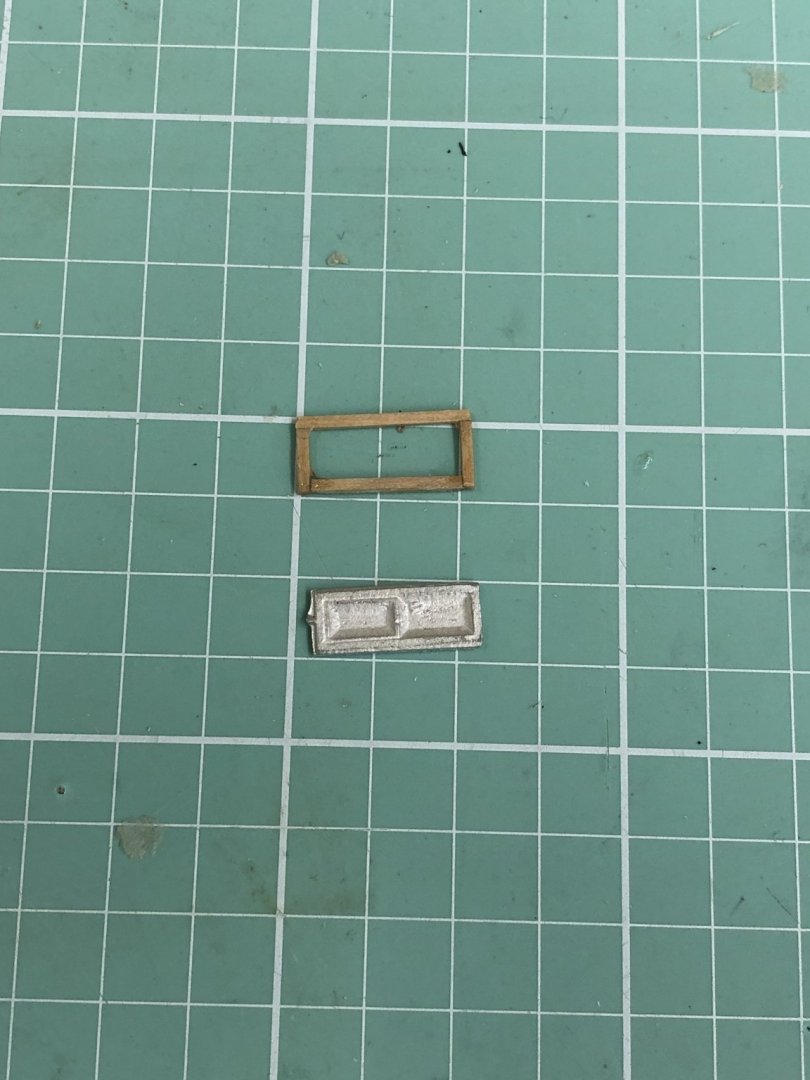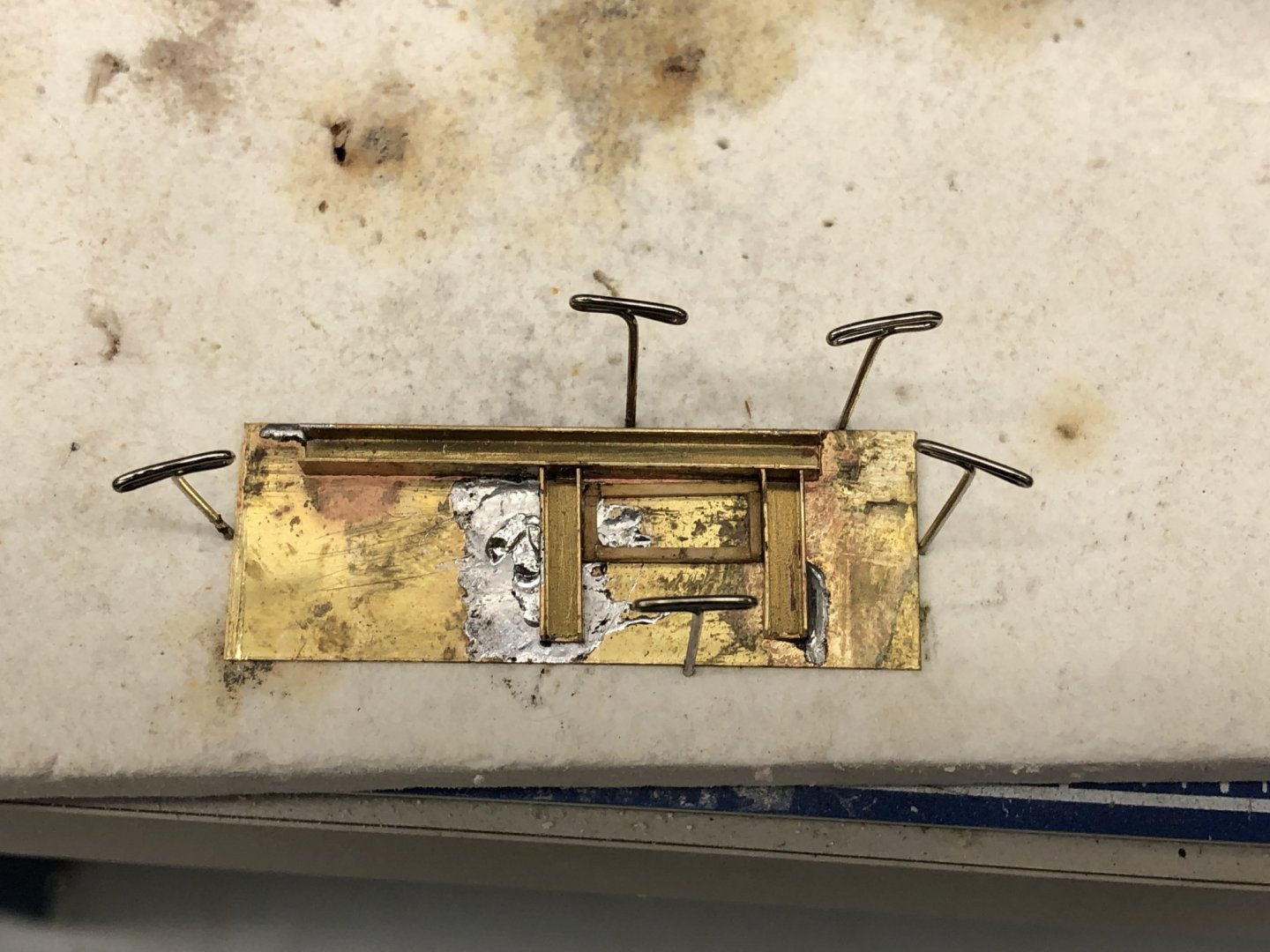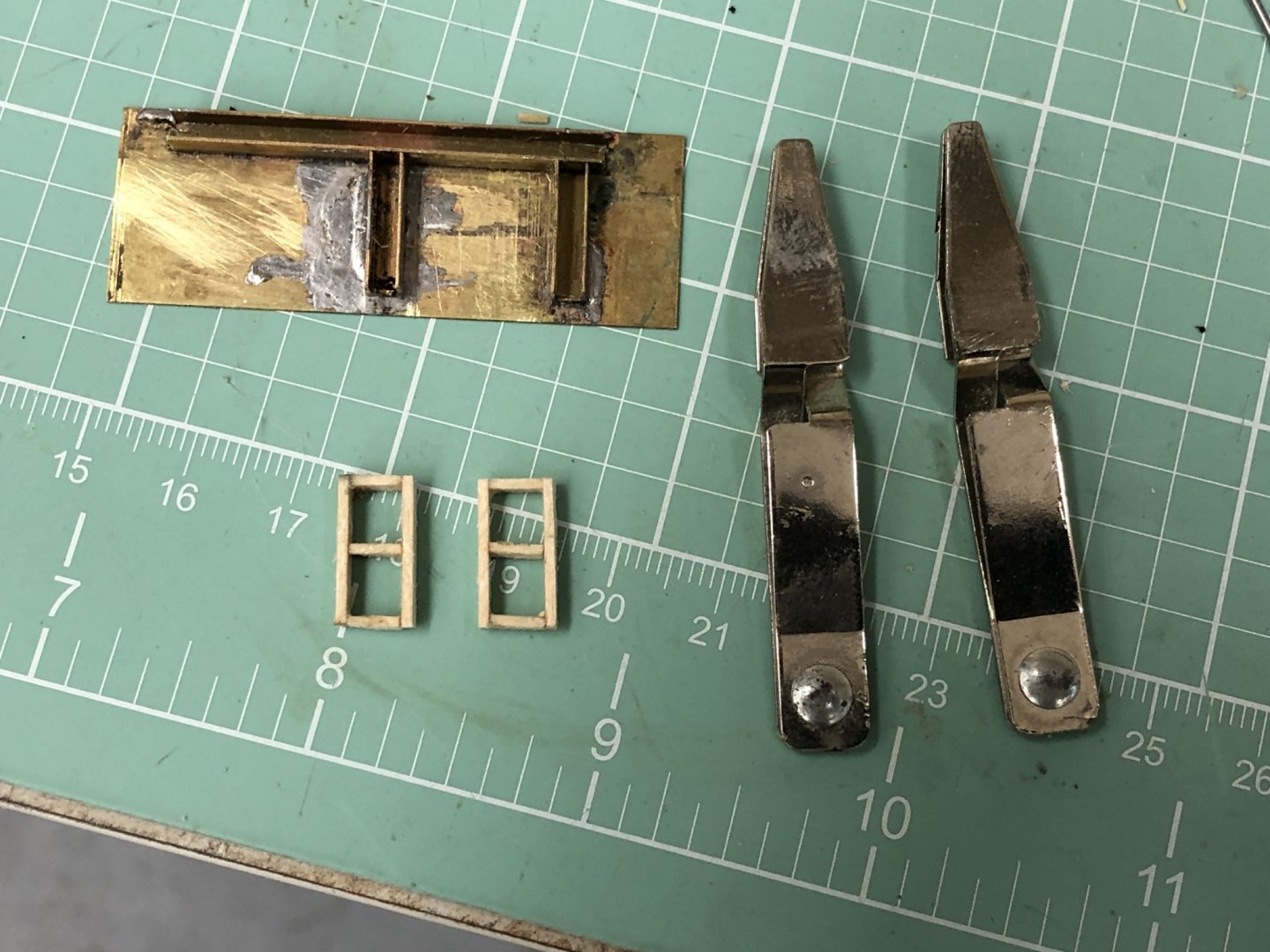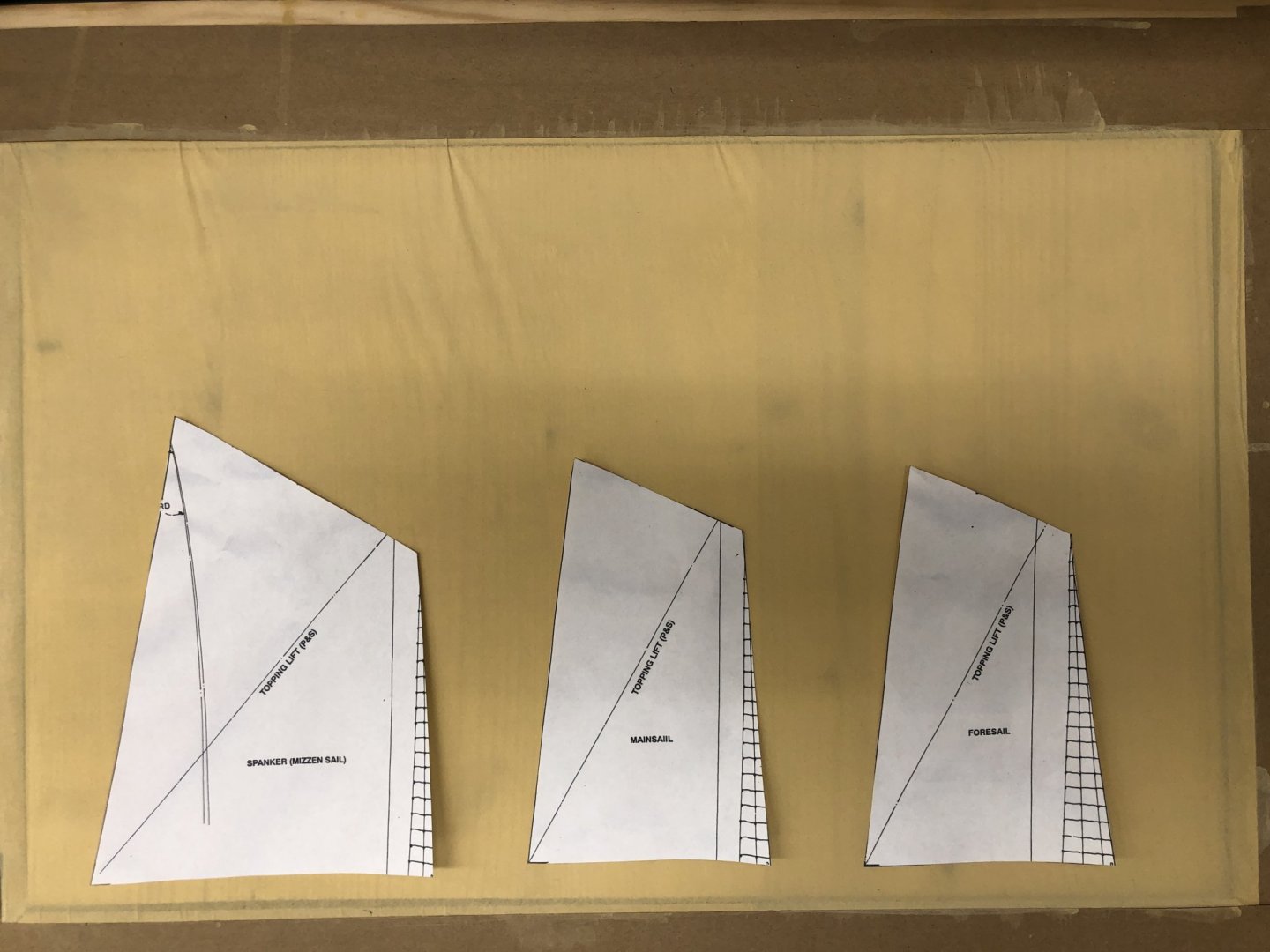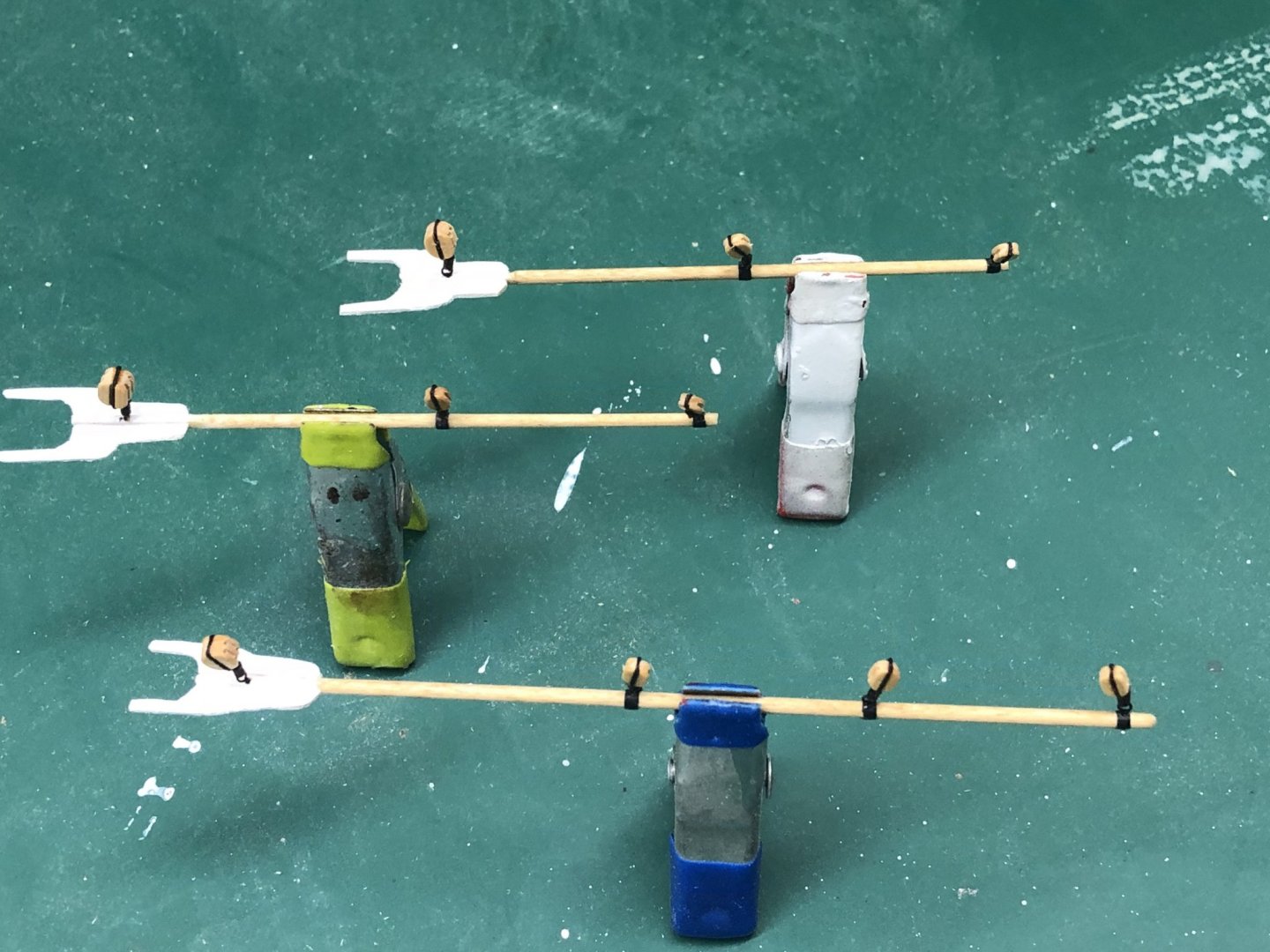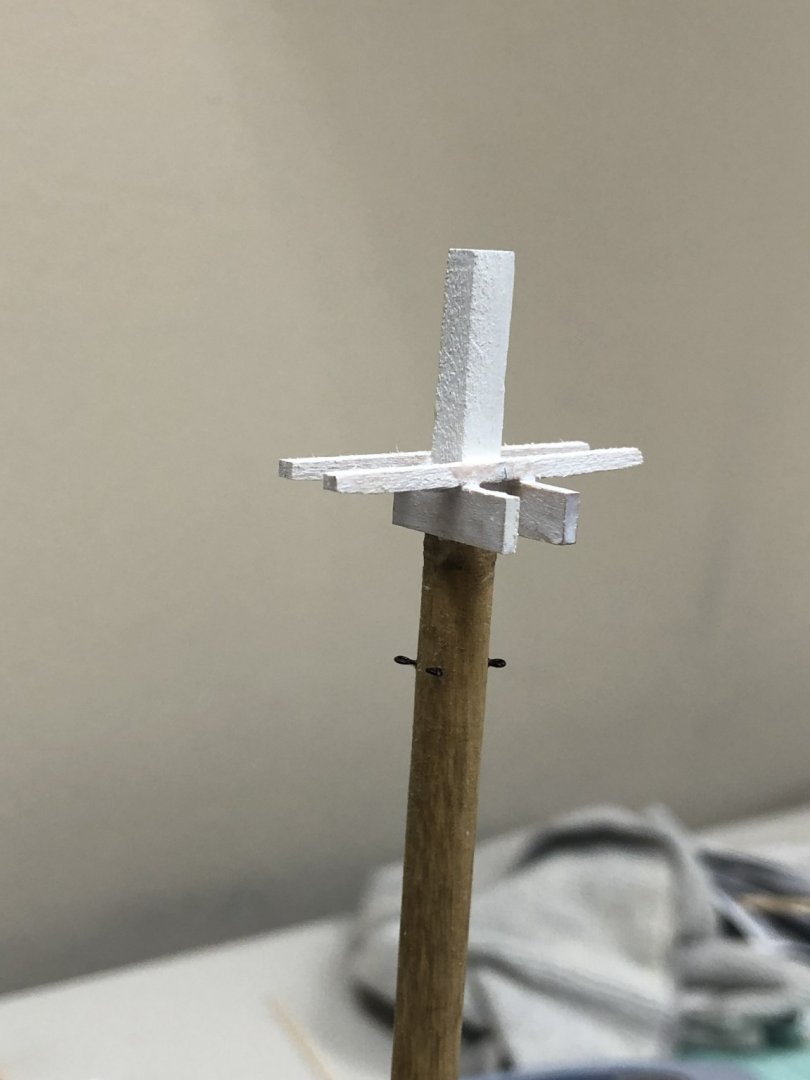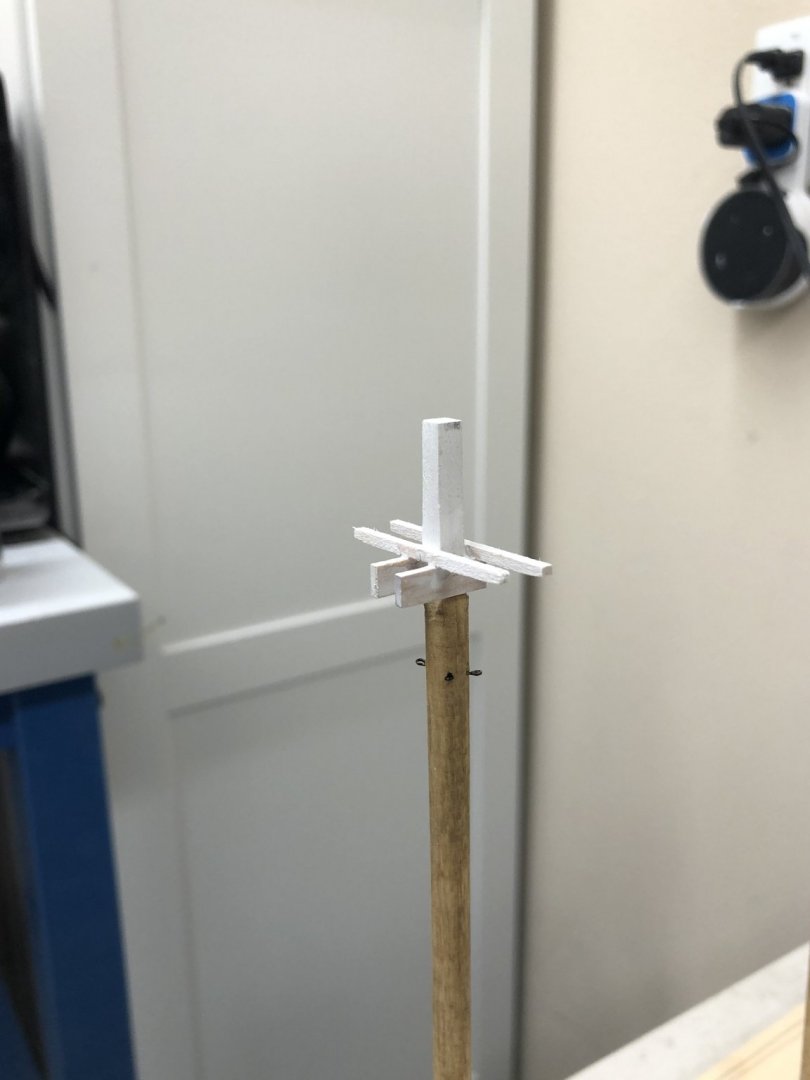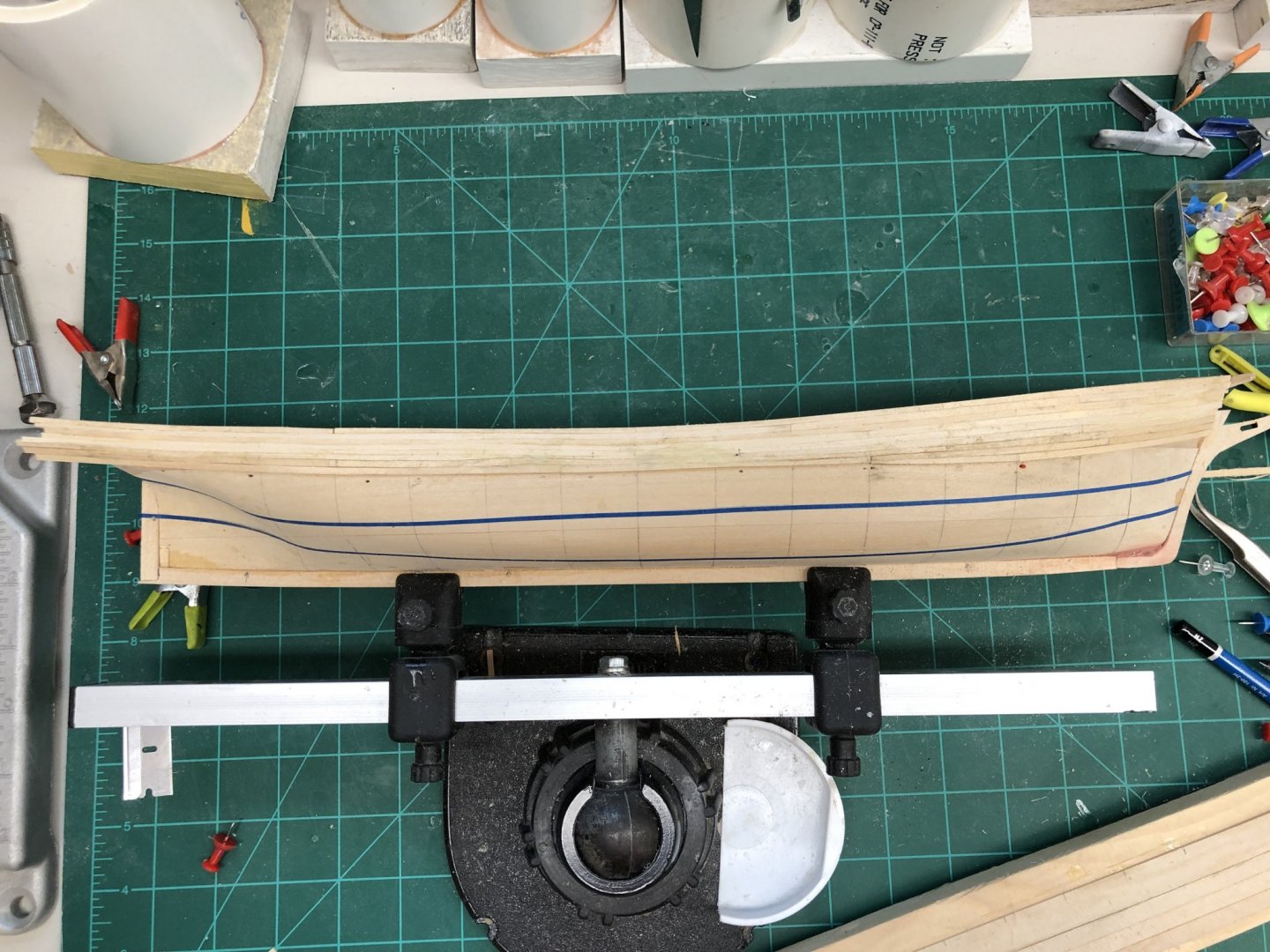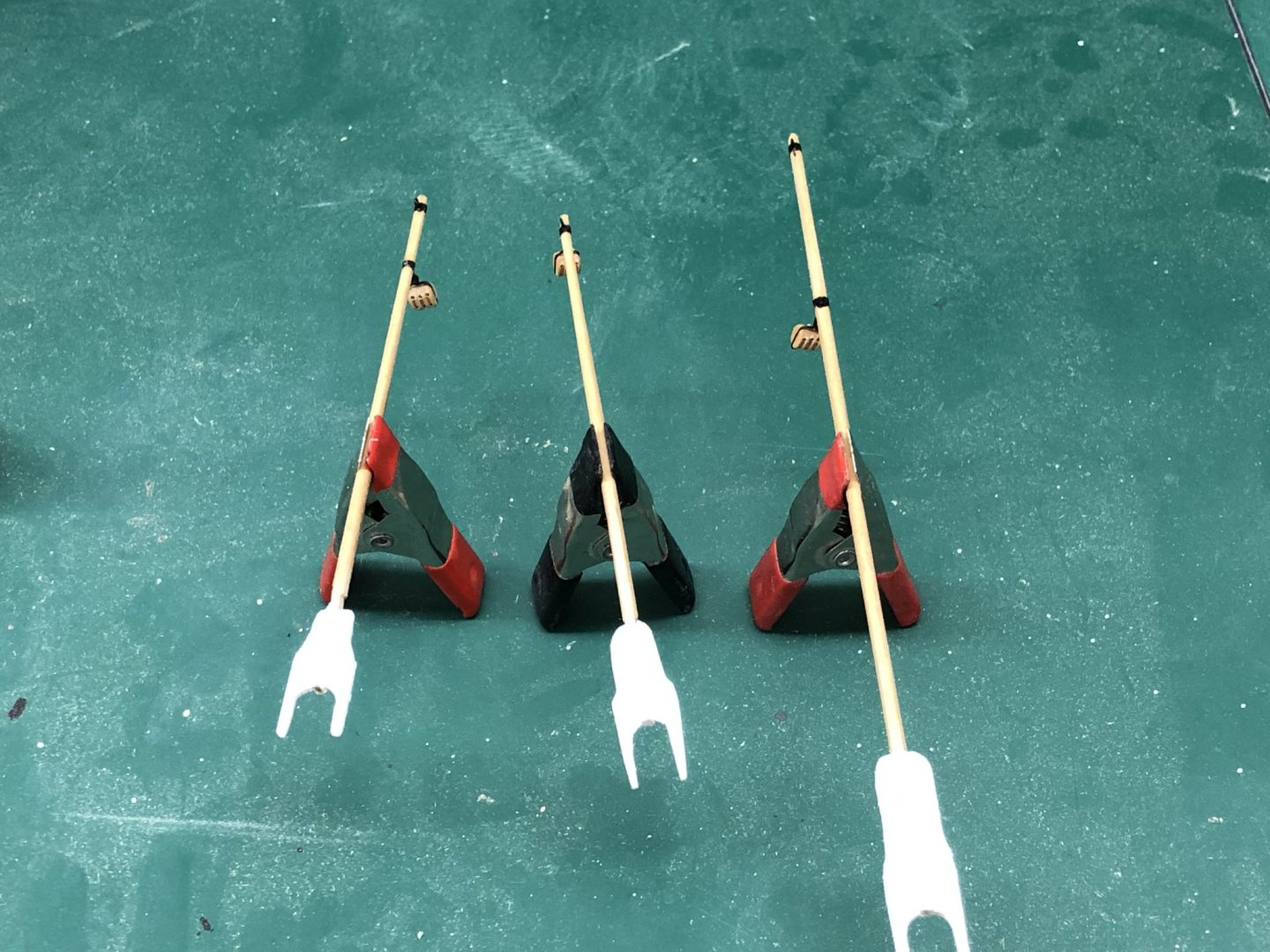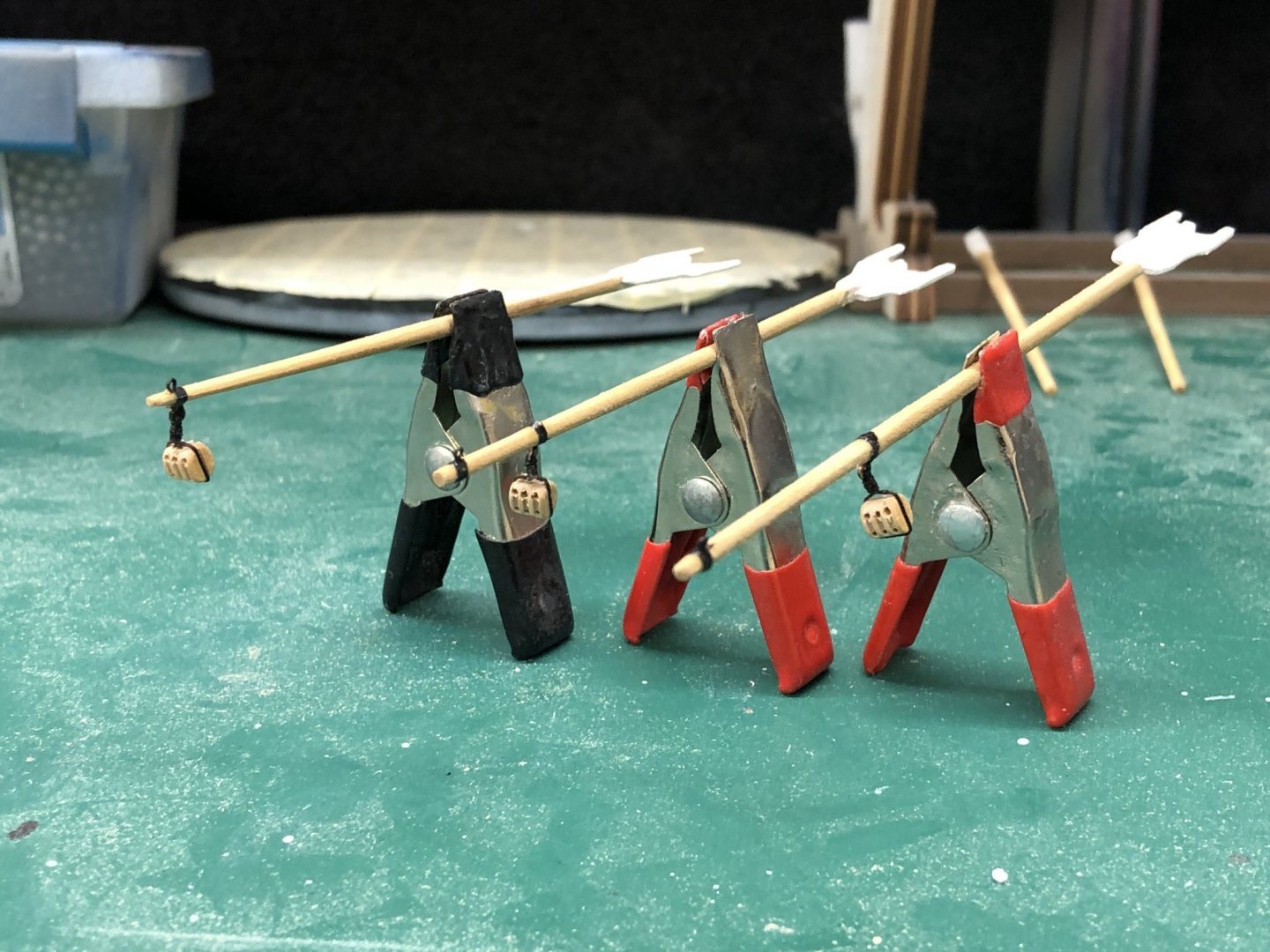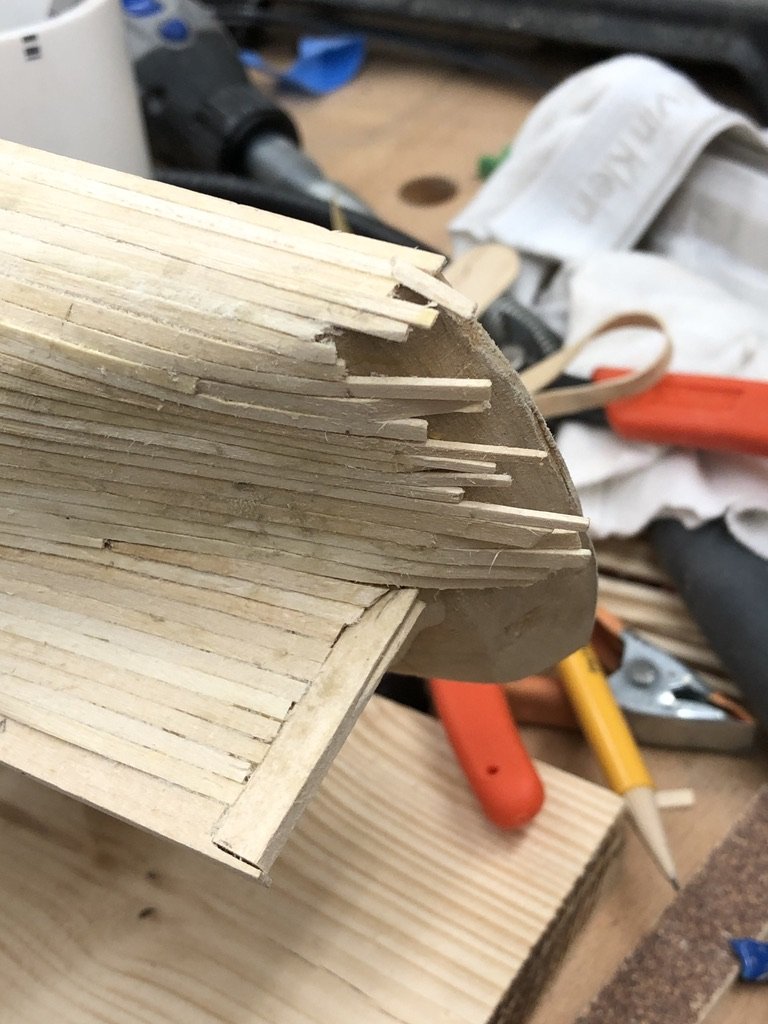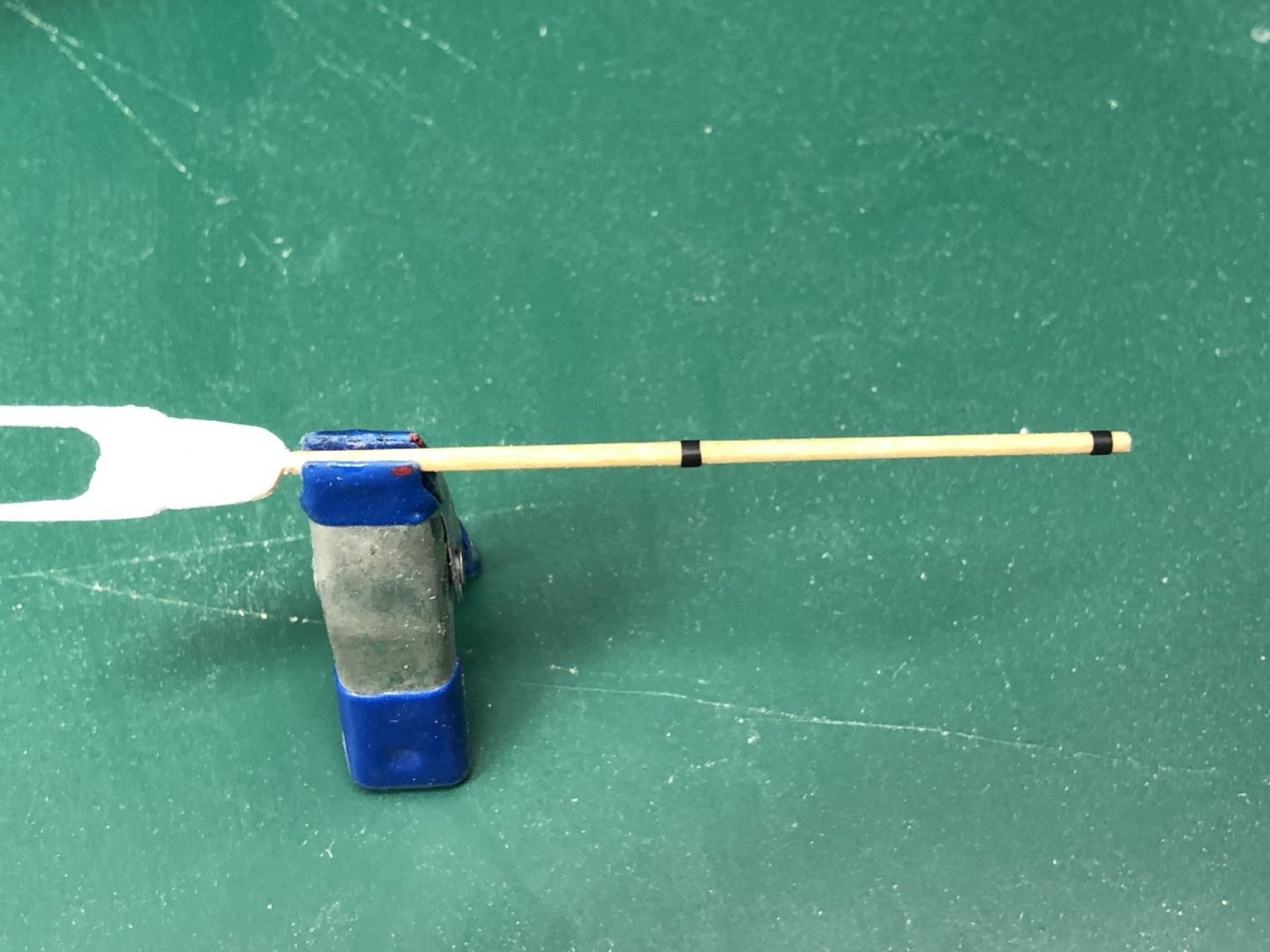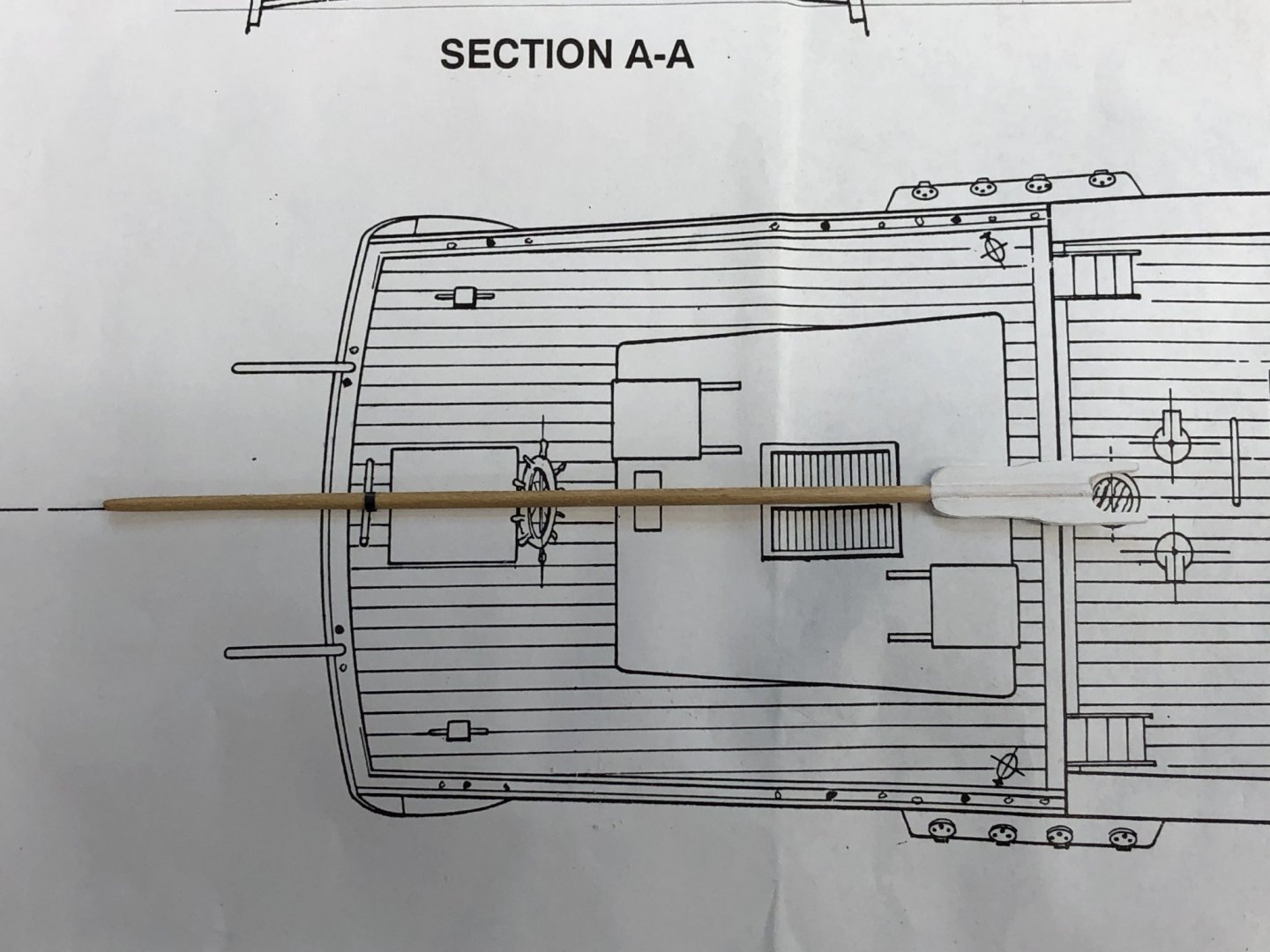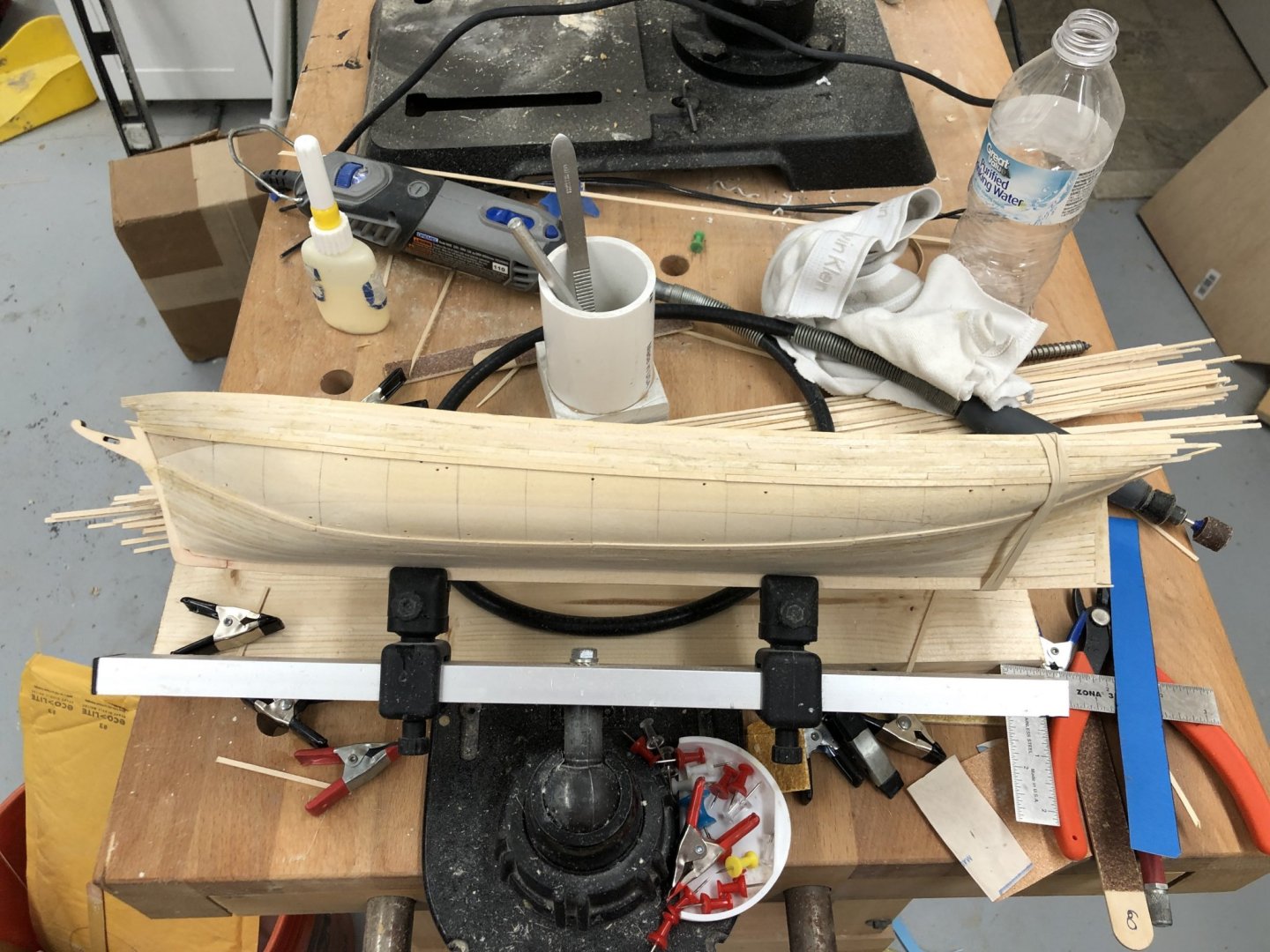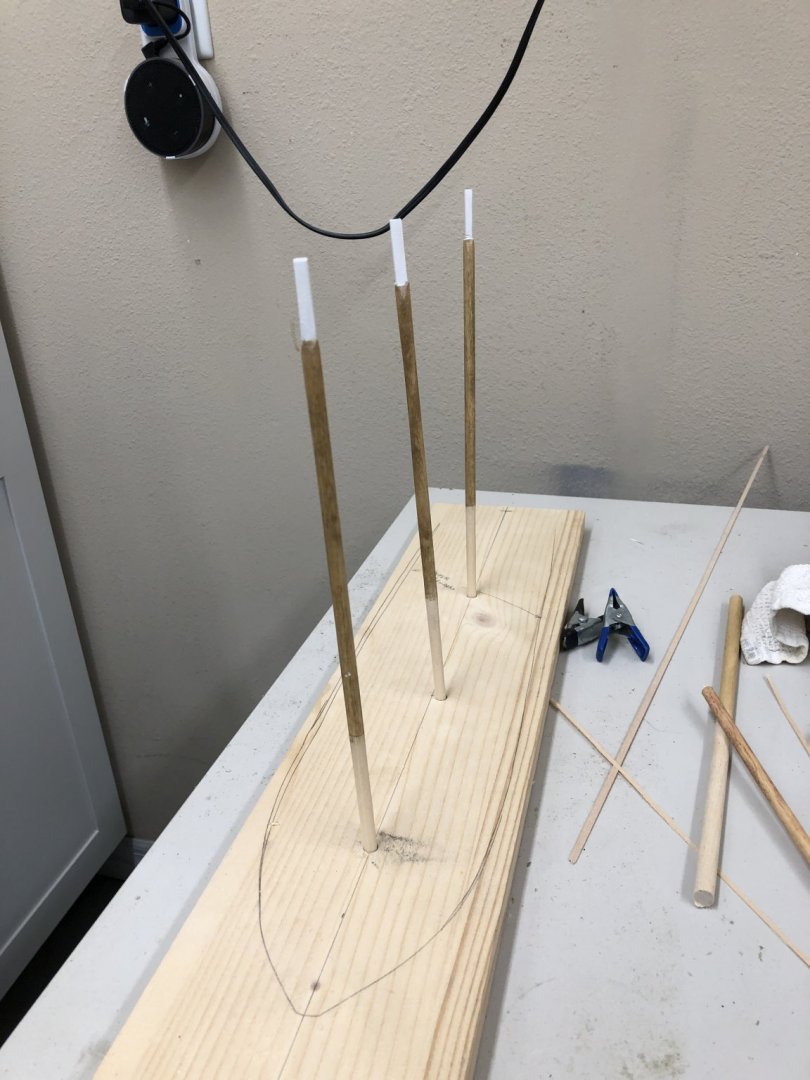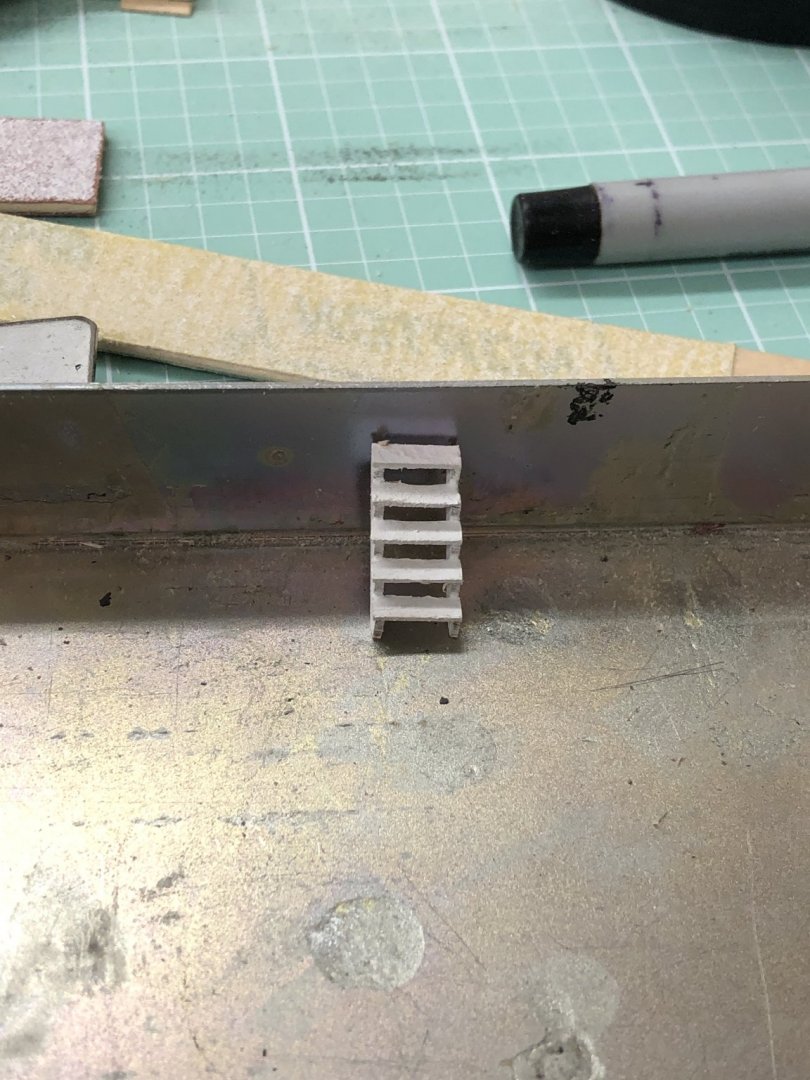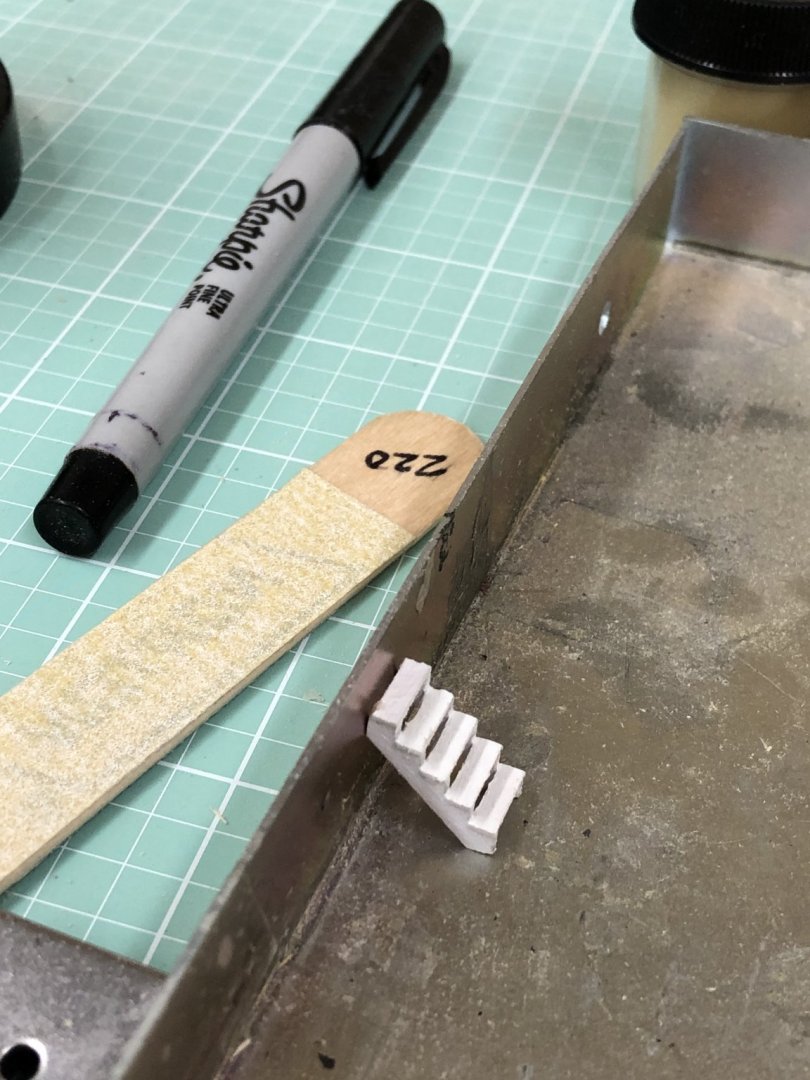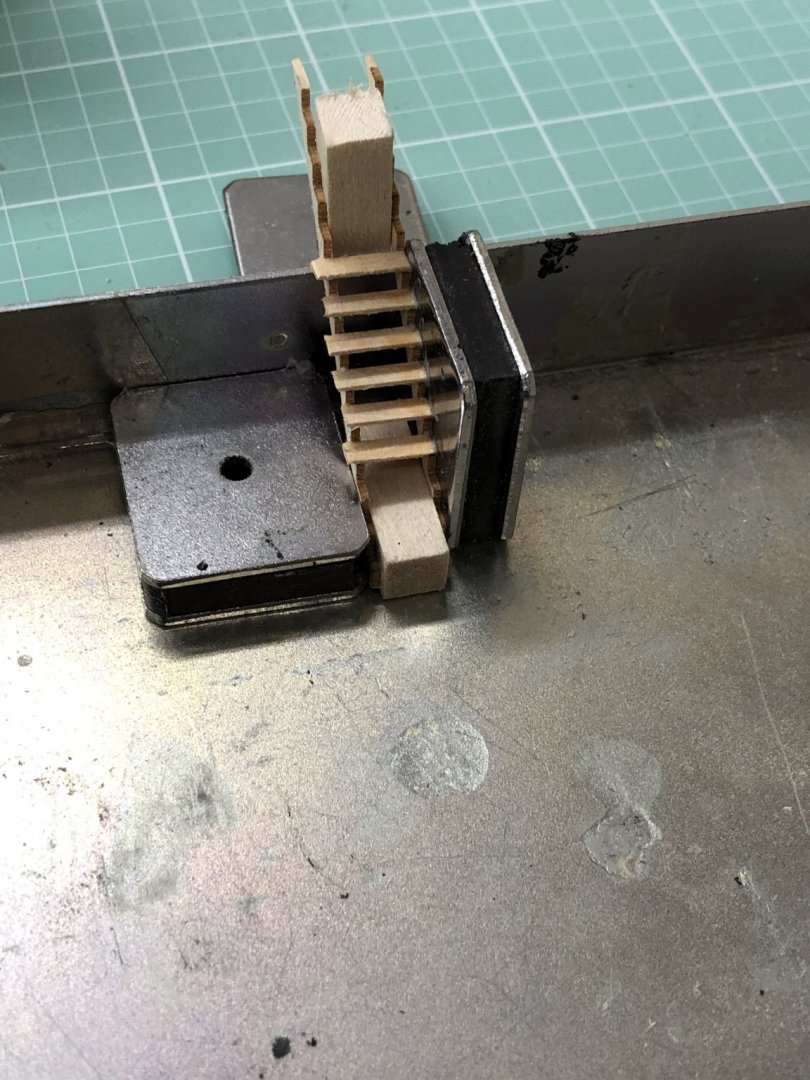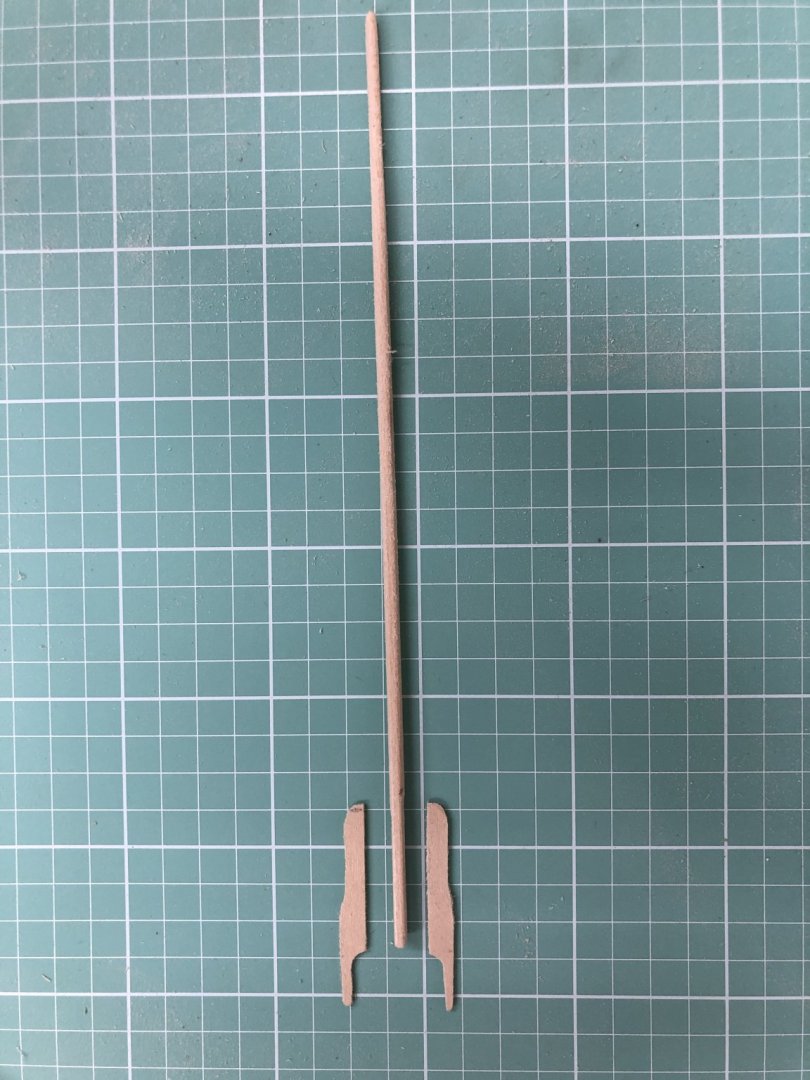-
Posts
1,915 -
Joined
-
Last visited
Content Type
Profiles
Forums
Gallery
Events
Everything posted by cdrusn89
-
I seem to recall somewhere a "rule of thumb" of 3 or 4 times the diameter of the deadeye for the space between them. That looks pretty close to me.
- 90 replies
-
- finished
- Midwest Products
-
(and 1 more)
Tagged with:
-
Also while waiting for glue to dry I started looking at the deckhouses. I was not impressed with the kit provided windows as I do not see how (short of cutting the "glass" out and just using the "frame") they could be made "presentable". Someone with a steadier hand and more patience than I could paint the frames white and the "glass" black but I think I can do better. My first attempt at making a window frame is shown below. I used 1/32 X /32 boxwood for the frame and had a devil of a time gluing the joints together. There is just not much contact area for the glue to grab. Since this was the third attempt at a frame and there are eight required I thought I better search for a better solution. I used some scrap brass to solder up a "form" to hold three sides of the frame together. I also decided to use the 3/32 X 1/32 planks from the hull as the sides of the window frame. I did this because I am going to build the deckhouses from 1/32" sheets rather than use the kit provided wooden blocks. I plan to use an additional 1/32" sheet for the siding on the deckhouses. If I mount the window frame flush with the inside of the deckhouse then the 3/32" thick frame will extend outside the siding by 1/32", similar to using the kit provided windows on the solid deckhouse. Here are pictures of the jig assembly and the first two frames.
- 166 replies
-
- fannie a gorham
- finished
-
(and 1 more)
Tagged with:
-
I have also been making preps to at least attempt to fit furled sails (for the fore, mail and mizzen sails only). I used the jig I built to put furled sails on the Latham and the same silk span material. Here is the colored (acrylic paint in a tube diluted with water - five coats applied so far) material with the full size sails. My plan is to cut the sails about 2/3rds of the full height to reduce the amount of material that has to be furled. Since the plans do not show any reinforcing or panel lines I am going to have to do some research (or find my Latham plans) to see how large the panels should be. On the Latham I used 1/16" (or maybe it was 3/32s or 1/8 since the Latham was 1/48 scale) masking tape to simulate the sail seams. That worked okay but I am going to try using colored pencils here first. I have both 3/64 and 1/32 masking tape on hand so I can revert to that if colored pencils does not prove satisfactory. Based on my Latham experience very little of the seams actually shows. There are not mast hoops included with the kit (unusual considering BlueJackets has mast hoops for sale on their site). I ordered enough to put 12 on each mast although I will probably break a few along the way. The BlueJackets hoops are 1/32" thick which would be 3" at scale which seems reasonable but will see how they look on the mast. The sails are just over 5" tall (~ 40' at scale) so a hoop every four feet (10 per mast) does not seem unreasonable. That means a hoop every half inch or so on the model. I have not decided how to attach them yet. On the latham I used .005" line but think I might give white glue a try here. Another thing I had thought of was actually attaching every other hoop since much of that detail is covered up by the sails. Much to ponder.
- 166 replies
-
- fannie a gorham
- finished
-
(and 1 more)
Tagged with:
-
While finishing up the planking I also added the eyebolts and blocks to the gaffs. The instructions say that the blocks on the gaffs should be 3/16" which (IMHO) seems pretty big. Since the instructions provide no (as far as I can tell) guidance on the line size to be used I think 3/16" is pretty big (18" block at scale). I tried using 1/8" (the other size specified in the kit) but that did not look "right" so I compromised and used 5/32" blocks from Syren Ship Model. I will use the same size on the masts as I can see no reason to change sizes. As I understand things, the block size is mostly determined by the line size that will pass through it. The heavier the line the bigger the block since the bend radius of the line is a function of line size and the bend radius required is defined by the size of the block. Trying to bend a thick line around a too small block leads to all kinds of problems. So here are the three gaffs ready for mounting, except for the parrels.
- 166 replies
-
- fannie a gorham
- finished
-
(and 1 more)
Tagged with:
-
Hull planking is complete. I left the stern planks extra long as I think the transom installation is not done until much later. I will have to give some thought to how to protect the planks sticking out. Maybe I will need to amend the order of installation. Here is what the hull looks like after an initial sanding with 120 grit and a wipe down with paint thinner.
- 166 replies
-
- fannie a gorham
- finished
-
(and 1 more)
Tagged with:
-
I decided that the ship's boat I built from the Model Shipways kit did not have enough "character". I had attempted to getn the "clinker" look to the yawl on the Niagara I built without success so decided to try it again. I used HO scale 1" X 8" (they come in 11" lengths) from Northeastern Scale Lumber for the planks. I reality it is really thin, probably just over 1" at 1/96 scale (since HO is 1/87) but close to 1/64" in use. Here is how it looks with one side painted and the other bare. I will paint the other side in due course. It needs a bit of sanding - 400 grit or less. As I said it is really thin. I also need to fab the cradle, eyebolts and tie downs but that is all on the "To Do" list with a myriad of other tasks.
- 166 replies
-
- fannie a gorham
- finished
-
(and 1 more)
Tagged with:
-
With 22 rows completed I turned the hull over and will start planking from the garboard strake up to meet just below the turn of the bilge (where any "extraordinary" measures will not be too easy to observe). One of the advantages of the shallow draft hull.
- 166 replies
-
- fannie a gorham
- finished
-
(and 1 more)
Tagged with:
-
Waiting for glue to dry - added cross and trestle trees to Fore Mast. Futtock shroud attachment eyebolts and holes drilled in cross trees. Attempting to form eyes in .013 wire, pass through holes in cross trees then secure (somehow) to eyebolts on mast. Keeping wire straight will prove a challenge. Added white paint to mast top and when that dries will see how the wire rigging goes. Clearly another coat of paint and some fine sanding is required.
- 166 replies
-
- fannie a gorham
- finished
-
(and 1 more)
Tagged with:
-
After looking at the hull with the top band planked and taking some measurements I decided to try a few rows of full size planks to see how things went. I got five more rows done and noticed things getting a little close at the bow so I started to taper the planks forward of about station 5. Here is what it looks like with 17 rows completed. I am going to do a few more from the top and then start with the garboard strake and work up.
- 166 replies
-
- fannie a gorham
- finished
-
(and 1 more)
Tagged with:
-
While waiting for Santa to arrive I managed to get band 1 of the stbd side completed. Going forward I will use my proportional dividers rather than trying to match tick marks on the hull. I also made up a simple jig to assist in cutting the planks to size. Given where I am now it might have been a better idea to start with 1/8" rather than 3/32" planks. Even though 1/8" would be 12" at scale it seems that the max width is only "in play" in fairly short sections.
- 166 replies
-
- fannie a gorham
- finished
-
(and 1 more)
Tagged with:
-
Alternating between hull planking and spars. Have the three booms completed with sheet block (3/16" Triple) and an eyebolt at the end for the topping lift. I suppose the topping lift lines might be just fastened around the boom with an eye but an eyebolt will make things easier and they might have been that way also. I am going to add the holes in the jaws for the belaying pins for the topsail lines even though I have not decided yet whether to include those lines in the model.
- 166 replies
-
- fannie a gorham
- finished
-
(and 1 more)
Tagged with:
-
For the starboard side I am following the more conventional approach that is outlined in several places (including here:http://modelshipworldforum.com/resources/Framing_and_Planking/Lining Off your hull for planking). The starting point is determining the number of rows of planking required. At the widest point (which is a bit forward of amidships due to the rising bulwarks) it is 3 1/2" which will take 38 planks 3/32" each. So the total, number of planks is 38. Two (the top two) bands of 9 and two bands of 10 (bottom two - based on an eyeball estimate of which are the widest of the four). Now to determine the plank widths at each "bulkhead" (which is this case is every other station line). I decided to only do one band at a time, starting with the top one. This way I have a known starting point for the next band - I am not sure I can "hit the marks" every time so I need some "wiggle room" about exactly where the next band will start. After marking the plank widths I got the top row of the upper band in place. Based on measurements the planks are full width until about the fourth station then taper to about 2/3 the width amidships and just over half at the stern. At the bow I am just butting the planks into the ones sticking out from the other side. This will have to be cleaned up later and the hole for the bowsprit fits in here too somewhere.
- 166 replies
-
- fannie a gorham
- finished
-
(and 1 more)
Tagged with:
-
Mark - I will try and do a better job of explaining what I did for the starboard side. Before I installed the keel and stem pieces I sanded a small bevel where the pieces would meet the hull to get a rabbit for the planks to fit. I did not make the bevel very large as the planks are only 1/32" thick. As far as a bearding line goes, I sanded the stern area to 1/16" (evenly distributed on each side) less than the 1/8" stern post width. Doing this by working toward the stern along the hull pretty much defined a bearding line although I did not do anything explicit to define one. With a 1/32" gap between the solid hull and the stern post on both sides the planking would be flush with the stern post.
- 166 replies
-
- fannie a gorham
- finished
-
(and 1 more)
Tagged with:
-
Back from cruise (weather was pretty rough last two days - of seven so overall pretty nice). Just as I was going out the door I got the planking on the port side finished. Not the best job I ever did. I ended up with a bunch (see blue circles below) of dropped planks in the middle where the two belts came together and had to use a few 1/8" wide planks to avoid other issues. I was just "laying planks" and tapering where it seemed "right" as I moved along. Probably not the best approach but I wanted to see just how difficult the planking would be. (On Endeavour this approach worked perfectly - the only tapered planks were the last ones on each side but you only get that lucky once a lifetime I think - too bad I was not gambling at the time.) The stern is still a work in progress. I do not plan on doing anything more there until both sides are done and I see where the laser cut transom piece "fits in". For the stbd side I am going to proceed in a more conventional manner, laying out planking bands and calculating plank widths as I go along. More or less what you would do for a POB hull. Not sure it is going to look all that much better than the port side once both are sanded and a few small areas patched but we shall see. My major intend with planking over the solid hull is to get as much of the planking to show through the paint as I can without any grievous errors in the planking showing as well. Probably will not know how well I accomplished that goal until much later. I plan to sand (lightly) the hull (both sides) starting with 100 grit and going to 220 and 320 before I put on the primer. What I do after that will probably depend on how it looks after the primer. I gave some thought to colors while on the cruise and since I already have two models with black hulls (Bluenose and Ben Latham) and two dark green (Niagara and Pride of Baltimore) I think I am going to paint this hull a medium gray (with anti-fouling red below the waterline). I think I will do the cabin roofs in a lighter gray and the bulwarks in white. I just got the wood to plank the decks in cherry and probably will do the main rail in cherry as well.
- 166 replies
-
- fannie a gorham
- finished
-
(and 1 more)
Tagged with:
-
Signing off for a week to go cruising toward Central America. And then it will almost be Christmas.... Probably not much is going to get done before the 27th or so.
- 166 replies
-
- fannie a gorham
- finished
-
(and 1 more)
Tagged with:
-
Speaking of striping tape used for the spar bands - the adhesive on the tape does not last forever sitting in the shop. Likewise it probably will not last forever especially on these very thin spars like the gaffs. I put some flat clear acrylic over the tape to seal the edges and hopefully keep it from peeling up in the near future. And it takes the shine off the tape. So far the tape does not appear to any the worse for the experience but I am going to give it a few days before I do the rest of them.
- 166 replies
-
- fannie a gorham
- finished
-
(and 1 more)
Tagged with:
-
Working the spars for a break from planking - hull is nearing completion on the port side. Spars have been fabed per sheet 3 of the drawings. I was starting to put the striping tape on to simulate the metal bands where the eyebolts will be located when I came across some inconsistencies in the drawings. Below are parts of sheets 1 and 3 showing the mizzen boom. On sheet 1 is the quarterdeck and I put the Mizzen Boom where is appears it should go. The black band on the spar is the tape that I put on based on this drawing. The second picture shows my Mizzen Boom on sheet three which has the spar details. Clearly the band is incorrectly located on one of these - I looked at the hull and placed my bet on sheet 1. There is a similar issue with sheet 2 and 1 with respect to the boom tackle locations. Sheet 2 shows the Fore and Main Sail sheet tackle at the very end of the boom but the spar detail drawing shows the main sheet (and fore sheet) tackle some distance forward of the end. In this case sheet 2 is probably correct as the main sheet traveler is shown on sheet 1 to be forward of the bilge pumps which are close to the end of the main boom. However, it appears that for the Fore Boom sheet 2 is incorrect as it appears that tackle should be very near the end of the boom. Hopefully the next person to build this kit can take advantage of these issues rather than find out when installing the running rigging. Probably not really significant issues - have the tackle lead a bit forward (or aft) of vertical would not even be noticeable as we are o nly talking a small fraction of an inch.
- 166 replies
-
- fannie a gorham
- finished
-
(and 1 more)
Tagged with:
-
By my calculations I have 10-11 more rows of planking to go at the widest point. I need to figure out what to do about the "smile" that has developed near the bow. I have been tapering the planks toward the bow since the second or third row but it appears I am going to have to do somethning else pretty soon. In other news I have the three lower masts on a build board to facilitate getting them outfitted and I finished the stirs, painted them white and cut out one set to see how it looked.
- 166 replies
-
- fannie a gorham
- finished
-
(and 1 more)
Tagged with:
-
While waiting for glue to dry I decided to make up a spreadsheet for the rigging starting with the standing rigging. The kit provides three sizes of black line for the standing rigging. Per the instructions "the heaviest line is used for the lower standing rigging (between the hull and mastheads) and the medium is used between the mastheads and for all topmast rigging." To me that would mean the heaviest (presumably .035 or .045 but it is not marked or indicated in the parts list) would be for the lower shrouds and the Forestay and Jibstay (which both go from the Fore Masthead to the hull or Bowsprit. However, the instructions specific to the Forestay and Jibstay say that these are doubled .025 line and the instructions for the lower shrouds also call out .025 line. The kit provides 30' of the heaviest black line (more than any other size) but if the .025 is used for the lower shrouds, and Forestay and Jibstay (and presumably for the rest of the stays which go between the topmasts and either the hull or lower mast tops) then where exactly is the "heaviest" black line used? I have not built a kit at 1/96 scale before. But .025 line (I assume this is the diameter - when I measure with my digital calipers it is close to .025) would be ~ 2.5" or a bit more than 6" circumference. The Niagara kit I recently finished called for .035 line for the lower shrouds which at the 1/64th scale would be 5" circumference. That would seem to mean that the heaviest line provided in the kit would not have a home, except possibly for the anchors (although the kit provides 2' of .050 anchor cable). I think I will specify .025 for the lower shrouds and the doubled Forestay and Jibstay but use .018 for the upper shrouds and the other stays in my spreadsheet. All in all not a easy to understand rigging plan and I am somewhat confused about what size line is used where. The only part really clear is that the smallest black line is for deadeye lanyards and ratlines. As an additional point, although the kit provides two sizes of running rigging line I do not see anywhere where a particular size line is specified.
- 166 replies
-
- fannie a gorham
- finished
-
(and 1 more)
Tagged with:
-
I looked at the Britannia stairs that came with the kit (you are supposed to cut the one set in half to get a set for each side leading up to the Quarterdeck). I was not too impressed and I have never had much luck getting Britannia to take paint well (probably my lack of proper preparation). So while I was getting the plywood for Plan B for the Bulwarks (Northeastern Scale Lumber) I got some HO scale (1/87) stair treads. They turn out to be close enough for me to at least try to assemble a set. So here are the treads set up in my "deck furniture" fixture. The treads are hull planking thinned down to .020" which is still probably too thick (~ 2" at scale) but any thinner and it is difficult to get it through the thickness sander without breaking.
- 166 replies
-
- fannie a gorham
- finished
-
(and 1 more)
Tagged with:
-
After a somewhat fruitless search of my inventory of stains I finally found the Fruitwood (Min-Wax) that i decided tom use for spars. I also painted the six sets of jaws for the booms and gaffs. I will assemble the jaws/booms-gaffs and then paint the white parts of the booms and gaffs. I am on the fence about the parrels. My preference would be to rig them as I assemble the booms/gaffs and then remember to get them on the masts BEFORE the masts go onboard. That would be the easy way (as long as you remember). I am considering adding silkspan sails (furled) as I did on by B.J. Latham kit. That means essentially putting the boom/gaff/sail "assembly" on board as the lower masts are installed. Time (and two subsequent ship models) has dimmed my memory of that process so at the moment it is a desire rather than a "going to do". I have to remember to look for the frame I used on the Latham, it should be plenty big for these three sails. So here are the spars and jaws drying. They were hand painted, too small to go to the trouble to break out the air brush. The stain isn't as blotchy as it looks in the picture. I think the light is reflecting off the still wet stain causing that look.
- 166 replies
-
- fannie a gorham
- finished
-
(and 1 more)
Tagged with:
-
- 166 replies
-
- fannie a gorham
- finished
-
(and 1 more)
Tagged with:
-
I got tired of planking so I decided to see if I could thin the bulwarks down to something acceptable. Part of the rationale for this is my concern that the planking is going to require some "finesse" and it would be better if that was executed somewhere other than at the bulwarks for all to see. Much better (IMHO) to have that occur in some less obvious place. To start planking at the bulwarks so the two bands can "meet in the middle" I need to decide how to handle the bulwarks, at least for the port side although doing something different on each side is a last resort if something really ugly were to happen. So I started with the Dremel sanding drum and Xacto knife and got the "easy part" (where it is relatively straight down to an 1/8". I decided not to go any further in that area as at 1/16" it would be relatively easy to break a piece off with an unfortunate movement. I will take another crack at the bow area, where the material is still quite thick tomorrow and then start planking from the bulwarks down.
- 166 replies
-
- fannie a gorham
- finished
-
(and 1 more)
Tagged with:
-
Got 13 rows of planking done and here is what it looks like. I am taking a "wait and see" approach to planking. I have been tapering the planks at the bow and added one stealer (not very elegantly) at the stern but beyond that have just been laying one row after another. At the moment it doesn't look like "disaster is around the corner" but with planking you never know. Anyway here is what it looks like at this point. I also managed to get the main and Fore booms fabed. On to the gaffs now.
- 166 replies
-
- fannie a gorham
- finished
-
(and 1 more)
Tagged with:
-
Between rows of planking I got the Mizzen boom and boom jaws fabed. Waiting until I have all the spars fabed before I stain them. Will give all the spars a final finish sand with 220/320 grit before staining. Plan on using Min-Wax "Natural" as the stain.
- 166 replies
-
- fannie a gorham
- finished
-
(and 1 more)
Tagged with:
About us
Modelshipworld - Advancing Ship Modeling through Research
SSL Secured
Your security is important for us so this Website is SSL-Secured
NRG Mailing Address
Nautical Research Guild
237 South Lincoln Street
Westmont IL, 60559-1917
Model Ship World ® and the MSW logo are Registered Trademarks, and belong to the Nautical Research Guild (United States Patent and Trademark Office: No. 6,929,264 & No. 6,929,274, registered Dec. 20, 2022)
Helpful Links
About the NRG
If you enjoy building ship models that are historically accurate as well as beautiful, then The Nautical Research Guild (NRG) is just right for you.
The Guild is a non-profit educational organization whose mission is to “Advance Ship Modeling Through Research”. We provide support to our members in their efforts to raise the quality of their model ships.
The Nautical Research Guild has published our world-renowned quarterly magazine, The Nautical Research Journal, since 1955. The pages of the Journal are full of articles by accomplished ship modelers who show you how they create those exquisite details on their models, and by maritime historians who show you the correct details to build. The Journal is available in both print and digital editions. Go to the NRG web site (www.thenrg.org) to download a complimentary digital copy of the Journal. The NRG also publishes plan sets, books and compilations of back issues of the Journal and the former Ships in Scale and Model Ship Builder magazines.




